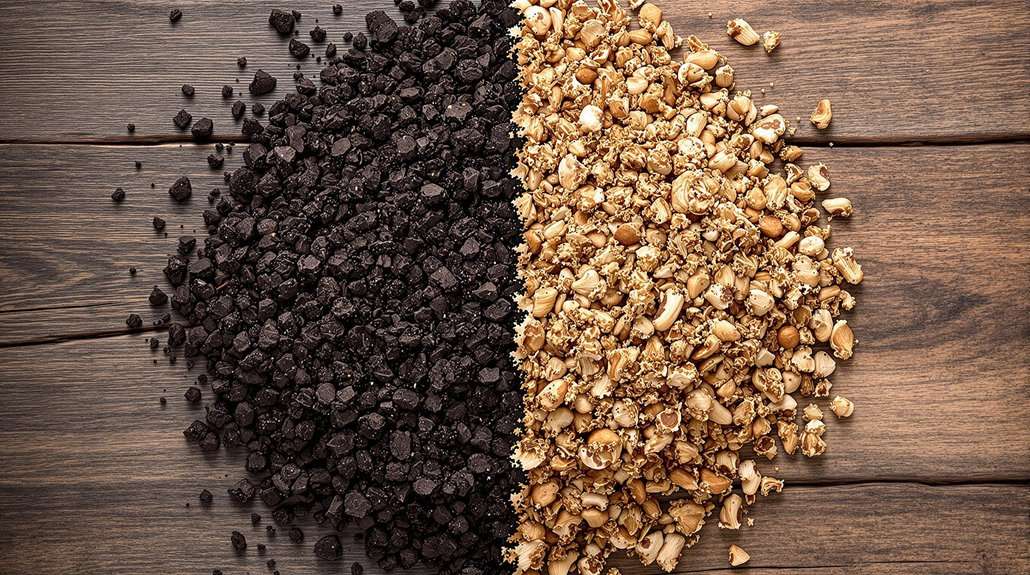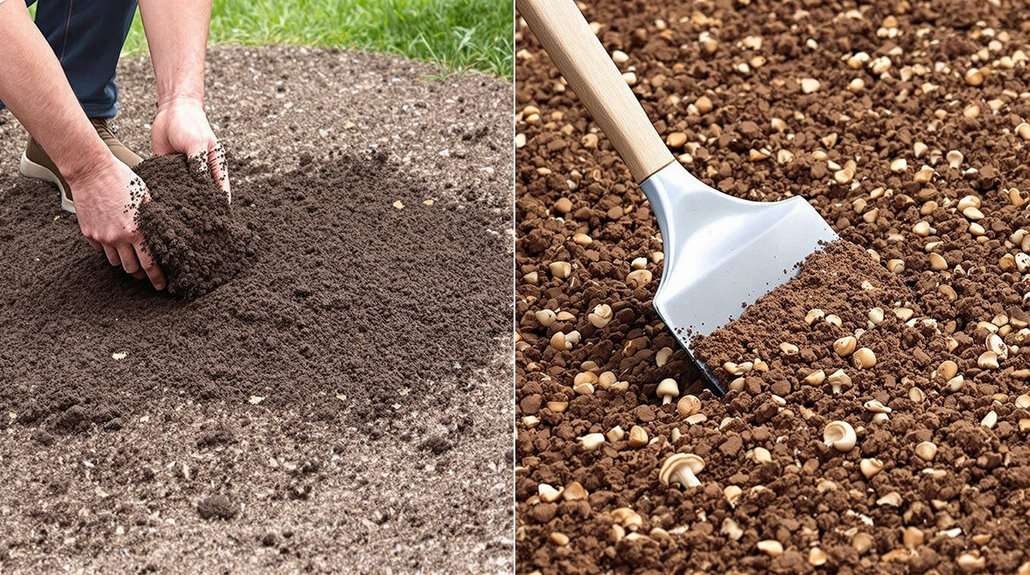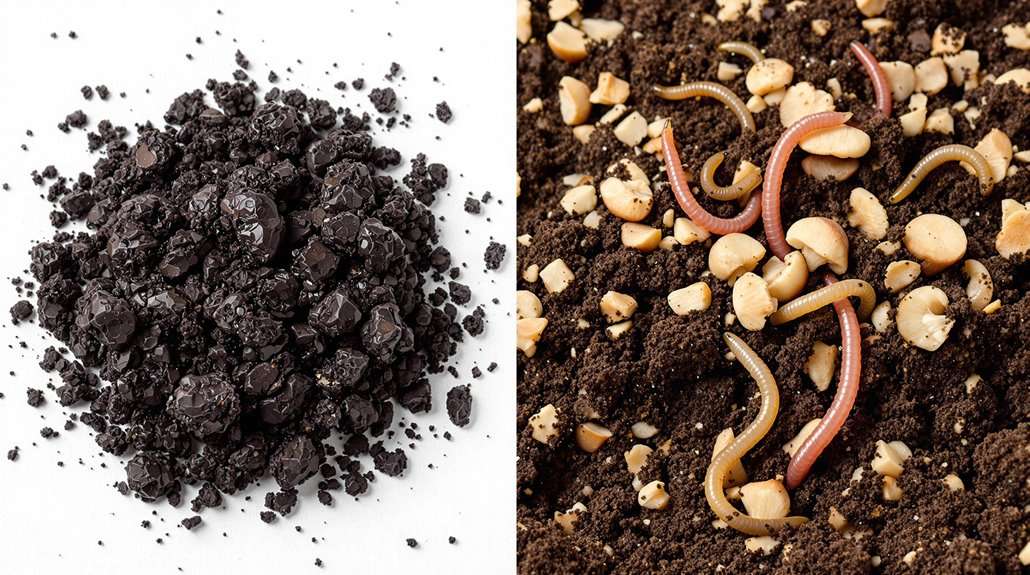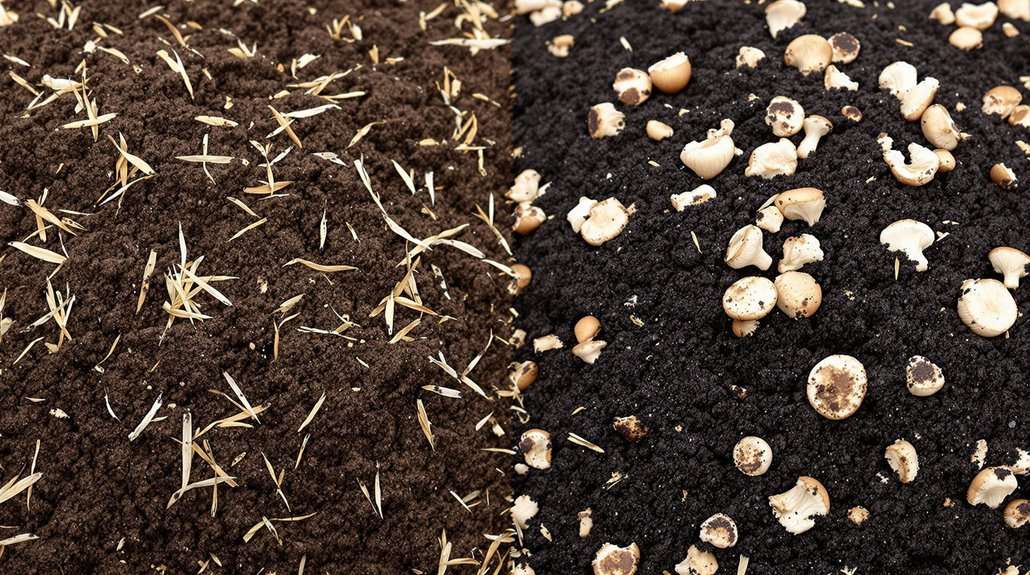Cow Manure Vs Mushroom Compost
When choosing between cow manure and mushroom compost, you'll need to evaluate your garden's specific needs. Cow manure offers higher nitrogen content (0.6-0.8%) and works best for leafy greens, while mushroom compost provides a more balanced nutrient profile with superior soil structure improvement. You'll find cow manure has an NPK ratio of 3-2-1 and neutral pH (5.9-7), making it ideal for nitrogen-hungry plants. Mushroom compost, with its alkaline pH (6-8) and slower nutrient release, helps prevent plant burning and improves moisture retention. Both amendments enhance microbial activity, though your specific crop requirements and soil conditions will determine the best choice for your garden's success.
This post may contain affiliate links. If you make a purchase through these links, I may earn a commission at no additional cost to you. Additionally, portions of this post may be generated using artificial intelligence (AI) technology. While we strive for accuracy, please be aware that AI-generated content may not always be perfect and should be fact-checked when necessary.
The Spatula Scoops
- Cow manure has a higher nitrogen content (NPK 3-2-1) than mushroom compost, making it better for growing leafy greens.
- Mushroom compost is pre-pasteurized and safer to use year-round, while cow manure requires 120 days before harvest.
- Both amendments improve soil structure, but mushroom compost has better water retention and carbon sequestration capabilities.
- Cow manure has a neutral pH (5.9-7), while mushroom compost is more alkaline (6-8), helping neutralize acidic soils.
- Mushroom compost releases nutrients more slowly and has less nitrogen leaching risk compared to cow manure.
What Are These Garden Amendments

Whether you're new to gardening or a seasoned enthusiast, understanding garden amendments is essential for soil health. Cow manure and mushroom compost are two popular options you'll encounter, each with distinct characteristics and benefits for your garden.
Cow manure is primarily composed of digested grass and grain, making it rich in organic materials and nutrients. You'll need to age or compost it before use, as fresh manure can contain harmful pathogens and weed seeds. When properly prepared, it's an excellent soil conditioner that improves moisture retention and helps break up compacted soil. The recommended nutrient content of composted cow manure is typically 3-2-1 NPK ratio.
Mushroom compost, on the other hand, is a byproduct of mushroom cultivation that's already been pasteurized, eliminating concerns about pathogens and weed seeds. It's particularly rich in phosphorus and nitrogen, containing a blend of organic materials like peat moss and straw. You'll find it's ready to use right away, requiring minimal processing before application.
Both amendments support beneficial microbial activity in your soil and contribute to improved soil structure. They're sustainable choices that reduce waste, enhance plant growth, and promote long-term soil health through increased organic matter content.
Nutrient Content and Benefits
When you're choosing between cow manure and mushroom compost for your garden, you'll find that cow manure generally contains higher levels of essential NPK nutrients, with composted steer manure offering nitrogen levels of 0.8% compared to mushroom compost's 0.7%. You'll notice that phosphorus content shows an even more significant difference, with composted steer manure containing 0.5% compared to mushroom compost's 0.3%, though both amendments provide excellent soil-building benefits. While cow manure typically has higher nutrient concentrations, mushroom compost's lighter texture and balanced nutrient profile make it particularly effective for improving soil structure and providing slow-release nutrients that won't burn your plants. It's important to note that fresh manure requires aging or composting before use to eliminate harmful pathogens and reduce excessive nitrogen levels.
Key NPK Differences
Understanding the nutrient profiles of cow manure and mushroom compost reveals distinct differences in their NPK values and overall benefits. You'll find that cow manure typically contains slightly higher nutrient levels, with nitrogen ranging from 0.6-0.8%, phosphorus at 0.2-0.5%, and potassium at 0.5-0.6%. In comparison, mushroom compost offers nitrogen at 0.5-0.7%, with both phosphorus and potassium at 0.2-0.3%.
When you're choosing between these amendments, take into account these key differences:
- Cow manure provides higher potassium levels, making it excellent for root development and overall plant strength.
- Mushroom compost offers more balanced NPK ratios, ideal for general garden use.
- Both materials contain similar phosphorus levels, supporting healthy flower and fruit production.
- Cow manure's higher nitrogen content makes it particularly suitable for leafy greens.
While cow manure's nutrient content can vary depending on the source and storage conditions, mushroom compost tends to be more consistent in its composition. The efficient digestion process of cattle helps concentrate nutrients in their manure, making it a valuable fertilizer option. You'll want to keep in mind that cow manure requires thorough composting before use, whereas mushroom compost is ready to apply immediately, though its higher salt content means you should use it cautiously around sensitive plants.
Micronutrient Impact Analysis
| Nutrient Aspect | Cow Manure | Mushroom Compost |
|---|---|---|
| Release Speed | Slower decomposition | Faster breakdown |
| Microbial Activity | Moderate levels | High concentration |
| Additional Sources | Bedding materials | Straw, gypsum, hay |
When you're planning your garden's nutrient strategy, you'll want to reflect on that mushroom compost's high microbial activity accelerates organic matter breakdown into humus, improving both water retention and soil structure. Meanwhile, cow manure's slower decomposition rate provides a more sustained release of nutrients throughout your growing season. The supplementary materials in mushroom compost, such as straw and gypsum, contribute additional micronutrients that complement its base composition. Your soil's specific needs should guide your choice, as both options effectively deliver micronutrients while offering distinct benefits concerning soil structure and long-term fertility management.
Ph Balance Effects
The pH balance effects of cow manure and mushroom compost create distinct soil-altering properties that you'll need to take into account for your garden's needs. When you're working with cow manure, you'll find it typically maintains a neutral pH between 5.9 and 7, making it versatile for various plants, while mushroom compost tends toward alkalinity with a pH range of 6 to 8.
You'll want to take into account these key differences when addressing your soil's specific requirements:
- Cow manure's neutral pH works exceptionally well for leafy greens and general vegetable gardens
- Mushroom compost's alkaline nature makes it ideal for counteracting acidic soils
- Both materials need proper maturation to stabilize their pH levels
- Brassicas particularly thrive with mushroom compost's pH range
If you're dealing with acidic soil conditions, mushroom compost will be your better choice, as it naturally helps neutralize acidity while providing beneficial organic matter. For optimal results, consider adding diluted urine solution to your compost to enhance nitrogen content and improve overall soil fertility. However, if you're looking to maintain a consistent, neutral pH while delivering balanced NPK nutrients, cow manure offers reliable performance. Remember that the pH effectiveness of cow manure can vary depending on the animal's diet, so you might want to test it before large-scale application.
Spreading and Application Methods

When you're ready to apply either cow manure or mushroom compost, you'll need basic equipment like wheelbarrows, shovels, and potentially a mechanical spreader for larger areas. Modern composting research shows that aerobic fermentation methods can significantly improve the quality of manure before spreading. You'll find the best results by spreading either type in early spring or fall, maintaining a uniform 2-4 inch depth and mixing thoroughly into the top 6-8 inches of soil. While both composts can be applied using similar methods, you'll want to adjust your spreading technique based on moisture content, as mushroom compost tends to be more granular and easier to distribute evenly compared to raw cow manure.
Direct Application Methods
Properly spreading and applying manure or mushroom compost can make or break your soil's health. When you're ready to apply either material, you'll need to evaluate several key factors, including timing, method, and safety precautions. Always wear protective gloves to prevent contact with harmful bacteria, and mix your compost with other organic materials to achieve the right carbon-to-nitrogen balance.
For optimal composting results, maintaining a water content of 50-60% is crucial during the application process. You've got several effective application methods to choose from, depending on your garden's needs and size. The lasagna method, where you'll layer your compost with carbon-rich materials, works well for larger areas. For smaller gardens, broadcasting a half-inch to one-inch layer provides excellent coverage.
Here's what you'll need to monitor during the application process:
- Temperature should maintain around 130°F to eliminate pathogens
- Moisture levels must stay consistent but not waterlogged
- Proper layering ratio between manure and brown materials
- Even distribution across your garden bed
Remember to avoid excessive applications year after year, as this can lead to nutrient buildup. If you're using fresh manure, you'll need to let it age for several months before applying it to your growing areas.
Equipment and Tools Required
Selecting appropriate equipment for spreading compost can dramatically improve your efficiency and guarantee even distribution across your growing areas. For large-scale operations, you'll find that both cow manure and mushroom compost can be effectively managed using wheel-type and chain plate compost turners. These machines offer impressive turning widths of up to 30 meters and can handle depths between 1.5 to 3 meters.
If you're working with cow manure compost, you'll want to think about using a tractor with a front-end loader and manure spreader attachment. This combination allows you to transport, mix, and distribute the composted material uniformly across your fields. For mushroom compost, you've got additional options including specialized small-scale turners and static fermentation tanks. These tools are particularly useful if you're managing smaller operations or need precise control over the fermentation process. The fermentation time period typically spans 20-30 days with proper management techniques.
Whether you're spreading cow manure or mushroom compost, you'll benefit from the energy efficiency of modern equipment. The latest turners consume 70% less energy than traditional models, while offering features like variable frequency speed control and automated discharge systems for peak performance.
Best Application Seasons
Timing plays an essential role in the successful application of both cow manure and mushroom compost. When you're working with fresh cow manure, you'll need to follow strict seasonal guidelines to guarantee food safety and peak nutrient absorption. Late fall application is your best choice for cow manure, as it allows sufficient time for decomposition before the next growing season. Dedicated handling tools should be used specifically for manure spreading to prevent cross-contamination.
Unlike cow manure, mushroom compost offers you much more flexibility in application timing. You won't need to worry about seasonal restrictions since it's already well-decomposed and pathogen-free. Here are the key timing considerations you should remember:
- Apply cow manure in late fall, at least 120 days before harvesting crops that contact soil
- Avoid spreading fresh manure in spring, especially for quick-growing crops like lettuce
- Use mushroom compost year-round without waiting periods
- Follow local regulations for manure application windows in your region
When planning your garden's fertilization schedule, you'll find mushroom compost's flexible timing more convenient for spontaneous soil amendments, while cow manure requires careful seasonal planning to maintain safety standards and enhance nutrient availability.
Cost Analysis and Market Availability
A thorough cost analysis of cow manure and mushroom compost reveals considerable price variations influenced by moisture content, nutrient value, and market conditions. You'll find that cow manure prices typically range from $25 to $100 per tonne, while moisture content can greatly affect the true cost of what you're buying. Recent analyses show that nutrient concentrations vary based on livestock feed quality.
When you're comparing costs, you'll need to take into account the hauling distance, which becomes economically viable within specific ranges – typically 1 to 19 kilometers from your location. The market availability of both products fluctuates seasonally, with certified organic options commanding premium prices. You'll notice that composted products with guaranteed nutrient analysis often cost more than raw, aged manure.
To determine the best value, you'll want to calculate the cost per ton of actual nutrients you're receiving. Remember that moisture content can markedly affect the real price – a $78 product might actually cost closer to $50 per ton when adjusted for water content. Additionally, you should factor in application costs, including equipment, labor, and storage requirements, which vary depending on your management system.
Effects on Soil Chemistry

Both cow manure and mushroom compost greatly influence soil chemistry through distinct mechanisms. When you're adding either of these amendments, you'll notice significant changes in your soil's nutrient content and overall chemical composition. Cow manure particularly excels at nitrogen retention and organic matter increase, while mushroom compost's unique composition helps regulate pH levels. Using cattle manure in composting leads to a 74.7% increase in humic acid.
You'll find these key differences in how they affect your soil's chemistry:
- The carbon-to-nitrogen ratio in cow manure promotes ideal microbial activity, leading to better nutrient cycling
- Mushroom compost combined with cow manure increases humic substances by up to 41.3%
- Both amendments help transform fulvic acid into humic acid, enhancing soil structure
- When combined, they create a more complex and stable bacterial network
The humification process is strikingly different between the two. While cow manure accelerates humic acid formation through direct microbial interactions, mushroom compost's contribution comes from its diverse organic matter content. You'll also notice that both materials help remediate soil contaminants, though cow manure's particularly effective at immobilizing phosphorus, copper, and zinc.
Garden Plant Compatibility
Understanding which plants work best with cow manure versus mushroom compost can greatly impact your garden's success. You'll find that cow manure's high nitrogen content makes it ideal for most garden plants, particularly when it's properly composted to eliminate pathogens and weed seeds. It's versatile enough for both seed starting and established plants, thanks to its generally neutral pH levels. Adding mushroom compost to gardens improves clay soil aeration significantly.
When it comes to mushroom compost, you'll want to be more selective. While it's excellent for established plants that need good moisture retention, you shouldn't use it for seed starting due to its high salt content. You're better off mixing it with regular soil to prevent waterlogging and dilute its salt concentration. For clay-heavy gardens, mushroom compost's straw content can considerably improve soil structure.
If you're working with sensitive plants, you'll need to dilute either amendment more thoroughly. Plants with high nutrient demands will thrive with cow manure, while your lawn can benefit from a light top-dressing of mushroom compost. For the best results, you might consider using both amendments strategically, matching each to your specific plants' needs and soil conditions.
Decomposition and Release Rates

The decomposition process and nutrient release patterns of these two composts directly affect how they nourish your plants over time. When you're comparing cow manure and mushroom compost, you'll notice considerable differences in how quickly they break down and release their nutrients into the soil. Cow manure compost typically shows organic matter content between 0.289 and 0.540, with lower values indicating more complete decomposition.
Mushroom compost, due to its extensive pre-treatment and pasteurization process, offers a more controlled decomposition rate. You'll find that its nutrients release more slowly and steadily compared to cow manure. The composition of straw, manure, and gypsum in mushroom compost creates a balanced nutrient profile. Here's what you need to know about the decomposition characteristics:
- Cow manure can lose up to 50% of its nitrogen during composting, affecting its long-term nutrient availability
- Mushroom compost's multi-step process results in highly stable nutrients
- The C:N ratio in cow manure considerably influences its decomposition speed
- Pasteurization in mushroom compost creates a more predictable release pattern
Your choice between these two composts should consider their decomposition rates, as faster-decomposing materials might provide immediate benefits but won't sustain long-term soil fertility as effectively as slower-releasing options.
Storage and Processing Requirements
When managing soil amendments effectively, proper storage and processing requirements play a crucial role in maintaining their nutrient value. You'll find that cow manure and mushroom compost have distinctly different needs when it comes to storage and processing.
For cow manure, you'll need to focus on active management. It requires covered storage to prevent nutrient leaching from rain, and you must turn the pile regularly to maintain proper aerobic conditions. The composting process is intensive, demanding temperatures above 130°F to kill pathogens and weed seeds, and you'll need to monitor moisture levels carefully throughout the several weeks or months of decomposition. Adding a tarp or landscape cloth during winter storage can help suppress unwanted weed growth while retaining valuable nutrients.
In contrast, you'll find mushroom compost much simpler to handle. Since it's already fully processed and pasteurized, you won't need additional composting steps. You can store it directly in plastic barrels or under tarps, as long as you keep it dry. While cow manure needs consistent aeration during storage, mushroom compost maintains its stability over winter with minimal degradation. Remember that longer storage of cow manure will result in nitrogen loss, while mushroom compost maintains its stability over winter with minimal degradation.
Environmental Impact Considerations

Through careful assessment of environmental impacts, you'll discover significant differences between cow manure and mushroom compost. While both materials serve as soil amendments, their environmental footprints vary considerably regarding emissions, water quality impacts, and soil health effects.
When you're considering environmental implications, mushroom compost often presents several distinct advantages:
- Lower nitrogen leaching potential, reducing the risk of groundwater contamination
- Better carbon sequestration capabilities, helping mitigate climate change
- Reduced pathogen concerns due to thorough composting processes
- More balanced nutrient release, preventing soil overloading
You'll find that cow manure requires more careful management to prevent environmental issues. Its high nitrogen content can lead to water pollution through runoff, and improper storage often results in significant methane emissions. The steam pasteurization process during mushroom compost production effectively eliminates harmful pathogens at temperatures of around 140°F. In contrast, mushroom compost's stable organic matter content and controlled processing methods typically result in fewer environmental concerns. When you're implementing either amendment, it's essential to follow proper management practices, but you'll generally face fewer environmental challenges with mushroom compost. The composting process effectively breaks down organic materials while minimizing harmful emissions and nutrient loss.
Mixing and Blending Guidelines
Mastering proper mixing and blending techniques will determine your success with both cow manure and mushroom compost. You'll need to maintain a carbon-to-nitrogen ratio between 25:1 and 40:1, which you can achieve by carefully balancing your materials. When working with either type of compost, you'll want to keep moisture levels at approximately 50% – use the squeeze test to check if the material holds its shape without dripping. The high water content in cow manure naturally helps maintain optimal moisture and temperature conditions for composting.
For cow manure, you'll need to add high-carbon materials like straw or sawdust to balance the nitrogen content. If you're working with mushroom compost, it's already been through an initial composting process, but you can still enhance it by adding diverse organic materials. Build your piles 4 to 6 feet high and 10 to 12 feet wide, ensuring proper aeration throughout the process.
You'll need to turn your compost pile every 1 to 2 weeks, regardless of type, maintaining temperatures between 131°F and 150°F for effective decomposition. Monitor oxygen levels, aiming for 5 to 20%, and add carbon materials if needed to improve airflow. Your finished product should be dark brown, crumbly, and emit an earthy aroma.
Frequently Asked Questions
Can These Composts Attract Unwanted Pests to My Garden?
While you might think all composts are created equal, they're not when it comes to pest problems. Your cow manure compost can become a pest magnet, attracting flies and other insects due to its distinct odor profile, especially if it's raw or improperly composted. On the other hand, you'll find mushroom compost less appealing to pests, making it a safer choice for your garden if you're concerned about unwanted visitors.
How Long Can I Store Each Type Before They Lose Effectiveness?
You can store cow manure for 3-6 months when properly covered and protected from the elements, though it's best to compost it first. For mushroom compost, you'll get peak effectiveness within 6-12 months of storage if you maintain proper moisture levels and keep it in a well-ventilated area. Both types should be stored on a solid base with protection from rain to preserve their nutrient content.
Do Weather Conditions Affect How Quickly They Break Down?
Weather conditions greatly impact breakdown rates. You'll find that rain accelerates decomposition by providing needed moisture, while high temperatures speed up microbial activity. In contrast, dry spells slow the process remarkably. When it's cold, breakdown nearly halts as microbes become less active. For best results, you'll want to apply these materials during moderate temperatures with adequate moisture, typically in spring or fall.
Can I Use Either Compost for Indoor Houseplants?
You can safely use both types of compost for indoor plants, but you'll need to prepare them properly. While cow manure compost should be aged for at least 6 months and limited to 10-20% of your potting mix, mushroom compost requires less aging but should be diluted similarly. If you're growing houseplants, make certain either compost is thoroughly decomposed to avoid odors and prevent nutrient burn.
Will These Composts Affect the Taste of Vegetables Grown?
You won't notice any taste differences in vegetables grown with either cow manure or mushroom compost. Research shows that while both improve soil fertility and plant health, they don't affect vegetable flavor. Your nutrients might be higher with these composts, but it won't change how your tomatoes or lettuce taste. Just make sure you're using properly composted materials to avoid any contamination issues.





